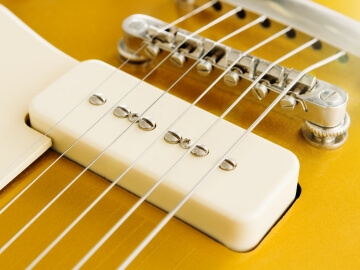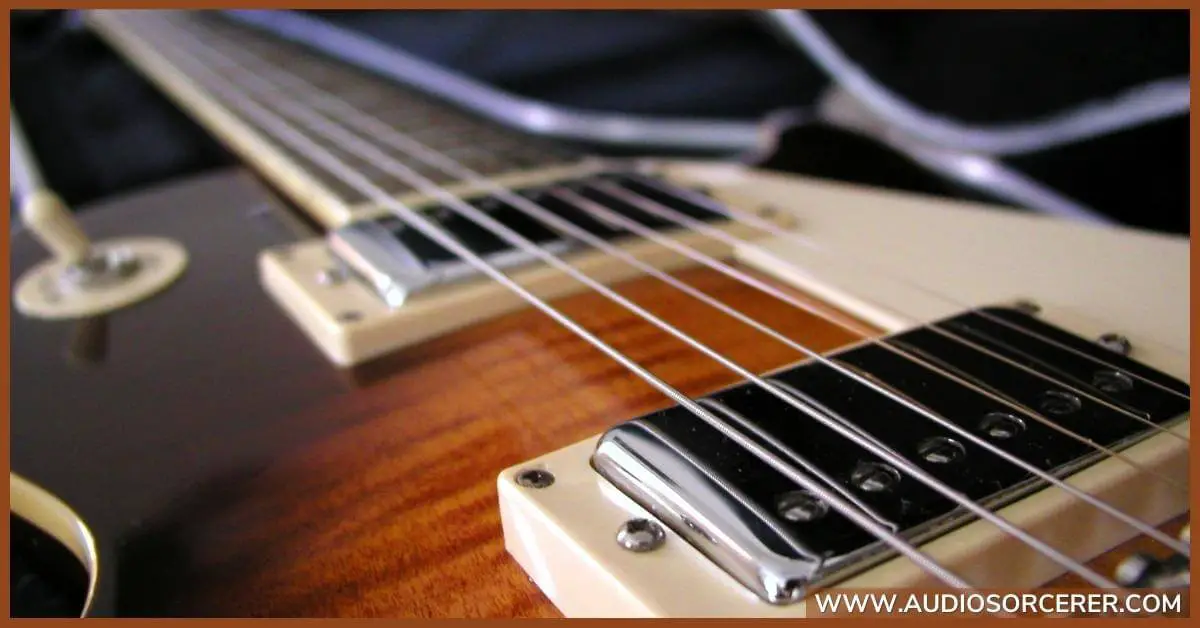
The magnetic, mystical world of guitar pickups is as fascinating as it is complex. Integral to the distinct voice of every electric guitar, pickups act as the bridge between physical and electrical realms, converting string vibrations into amplified sound.
In this journey into the realm of pickups, we gut out everything from the basic machinations of these tiny devices to the different types, shedding light on single-coil and double-coil 'humbucker' pickups, as well as rare but vital, specialized pickup types.
Along the course, we'll also unlock the secrets to selecting the perfect pickup type matching your style and genre, catalyzing your voyage towards an improved guitar setup.
A guitar pickup is a transducer that captures or picks up mechanical vibrations from a guitar's steel strings and converts them into an electrical signal. This transformation forms the basis for the guitar's sound output, taking raw strumming energy and embodying it in an electric current that amplifiers can boost and manipulate.
The primary components of guitar pickups are magnets and wire coils. When a guitarist strums or plucks a string, it vibrates at a certain frequency. This vibration creates a fluctuating magnetic field around the magnets in the pickup. The fluctuating magnetic field, in turn, induces a corresponding current in the wire coil.
Now, let's get into the different types of guitar pickups.

The single coil pickup is the oldest and simplest type of electric guitar pickup, having gained momentum by the 1930s. These pickups use individual magnets for each string, and the magnets are wrapped in a single layer of copper wire coil.
Single coil pickups are heralded for their bright and punchy sound signature. They are preferred by blues and country musicians due to the clear tones they produce. However, they are notorious for '60 cycle hum', a type of electrical interference caused by alternating current power sources that can taint the audio output.

Humbucker pickups are a savvy counter design to the single coil pickup, made explicitly to 'buck the hum' or cancel out the aforementioned electrical interference. This pickup type utilizes two coils of wire rather than one. The two coils are wound opposite to each other around the pickup's magnets, in a way that cancels out any interfering hum.
Humbuckers tend to have a thicker, fuller and louder sound compared to single coil pickups because of their double coil design. They are a go-to choice for rock and heavy metal musicians, but they also provide a warm, smooth tone suitable for jazz and classical genres.

The P-90 pickup offers a tonal balance between the bright single-coil and the thick humbucker. It's commonly described as having a 'bark' or 'growl' due to its punchy midrange character. Like single-coil pickups, P-90s use single coils. However, the structure is wider and shorter, leading to a distinctly different tone.
Introduced by Gibson in the 1940s, P-90 pickups are popular for their versatile sound that’s suitable for a wide range of music genres, from blues to punk rock. However, similar to single coil pickups, they are susceptible to electrical interference.

Active pickups are a category of pickups that use an onboard preamp, powered by an external battery source, typically a 9-volt battery. The preamp boosts the signal right at the pickup, resulting in a strong, clear output that overcomes long cable or intense processing demands.
While active pickups have a high output level, they also provide a relatively flat frequency response delivering a clean, balanced tone. They are a preferred pickup type for metal and progressive rock guitarists who need a consistent, distortion-free sound at high gain settings. However, an inevitable downside of active pickups is their requirement for battery power, which necessitates regular maintenance checks.
Related Article: How To Tune A Guitar Like A Pro - Easy, Simple, And Fast!

Signifying one of the earliest designs, single-coil pickups have deep roots going back to the early 20th century. The heart of these pickups is a single magnet, typically constructed from Alnico or ceramic materials. It's tightly wound by a slender wire, the essential component which converts the strings' vibration into an electric signal for the amplifier. The output and tonal characteristics of the pickup can be significantly influenced by the number of windings or 'turns'. While typically ranging between 8000 to 9000 turns, specific models intended for distinct uses can display significant variations.
Sound-wise, single-coil pickups are coveted for their bright, crisp, and clear tone that lends itself to a wide range of musical styles. They encompass a full frequency range that delivers transparent highs, punchy mids, and defined lows. Often, this type of pickup will have a certain 'twang' or 'bite' that makes it especially well-suited to genres like country, blues, classic rock, and surf music.
However, one of the defining properties of a single-coil pickup is its dynamic response. When you play softly, the tone is clean and clear, but when you play harder, it begins to break up and distort, adding character and grit to your sound. This responsiveness to your playing dynamics makes single-coil pickups a popular choice among expressive players who prize nuance and subtlety in their tone.
Numerous renowned guitarists have favored single-coil pickups. Perhaps the most notable is Jimi Hendrix who, with his iconic Fender Stratocaster loaded with single-coil pickups, created an explosive, groundbreaking sound that reshaped rock music. Other legends include Stevie Ray Vaughan, known for his blistering blues tone, and David Gilmour of Pink Floyd, whose single-coil-equipped Fender Stratocaster helped him craft some of the most memorable guitar solos in rock history.
Single-coil pickups possess qualities favored by many guitar enthusiasts. Notable for their bright and clear tone, they respond well to picking dynamics, a characteristic appreciated by expressive players. Furthermore, they have a lower-output, a quality that helps retain the natural acoustics of the guitar.
Despite their advantages, these pickups are not without drawbacks. Chief among them is their vulnerability to electromagnetic interference, leading to an undesired noise commonly known as 'single-coil hum'. Although humbucking versions of single-coil pickups, shielding the guitar cavity, and avoiding high-gain or noisy environments can reduce this hindrance, it remains a significant concern. Moreover, the brightness of single-coils, while preferred by some, can be seen as overly harsh or thin by players favoring heavier music genres.

In the mid-1950s, a significant milestone was recorded in guitar history with Gibson employee Seth Lover's invention of the humbucker, or double-coil pickup. With the introduction of two coils instead of one, Lover's creation wonderfully countered the annoying hum or sound interference linked with single-coil pickups. In a humbucker, the coils are wound inversely to each other, canceling out external interference and stray electrical noises. This ingenious feature offered musicians the opportunity to produce cleaner and more defined guitar tones, free from the formerly disrupting hum.
Humbucking pickups do not just offer noise reduction effects. Their peculiar design also provides a significant impact on the guitar's tone and volume. These pickups produce a fuller and hotter sound compared to their single-coil counterparts and this manifests as a thicker tone with less high-frequency responsiveness. In terms of volume, humbuckers are generally louder due to the combined output of two coils. As a result, they are popular among rock, metal, and jazz musicians who often require warm tones and high output levels.
Although the standard humbucker design is consistent, there are different sub-varieties that offer a wide range of tonal possibilities. Mini-humbuckers, for example, feature a smaller size and a narrower magnetic field, which provides a brighter tone. Bridge pickups are typically hotter and provide an edgy tone, while neck pickups are often softer and more round-voiced. Stack humbuckers are made by stacking two single coils vertically, which maintains the size of a single coil but still gives the noise reduction advantage of humbuckers.
Over the decades, humbucker pickups have found their way into the gear of numerous famous guitarists, owing to their distinct tonal qualities and superior noise-cancellation features. Among the prominent users of humbuckers was the virtuoso Jimmy Page of Led Zeppelin, who predominantly employed a pair of Gibson PAF (Patent Applied For) pickups. Guns N' Roses' eminent guitarist, Slash, too, relied on humbuckers to achieve his signature Les Paul sound. The extraordinary jazz guitarist, the late Wes Montgomery, was another popular enthusiast of the humbucker's ability to produce vivid warm tones.

P-90 pickups serve as a unique and adaptable option among electric guitar pickups, bestowing bright and lucid tones. These were the first pickups to provide a notable increase in electrical output relative to other contemporaneous models. Its dimension is considerably broader than a conventional single-coil pickup, which results in an expansive magnetic field, enabling more string vibration capture.
When considering tone, the P-90 is typically placed between a single coil and a humbucker. It imparts a warmer tone than the single coil while maintaining a level of brightness often missing in humbuckers. This juxtaposition of tonal attributes fosters a robust and full-bodied sound which remains sharp and energetic. Nevertheless, one potential disadvantage of P-90 pickups is their tendency to pick up electrical interference and noise.
Active pickups use a battery-powered pre-amplification circuit to boost the signal and often include additional tone-shaping controls. This allows for a high output signal that is less susceptible to noise and interference, providing a clean and consistent tone.
Additionally, active pickups can offer greater control over your guitar’s sound as the preamp allows for features like EQ controls. On the flip side, the use of a battery is sometimes seen as a disadvantage as it can run out and needs to be replaced. Additionally, the tone produced by active pickups is often seen as less "natural" than that from passive pickups due to the additional electronic processing.
When it comes to acoustic guitar pickups, Piezos are your go-to. They are inserted in or around the sound hole to amplify an acoustic guitars naturally resonant and full-bodied tone. These pickups work by translating the vibrations of the guitar body into an electrical signal using piezoelectric crystals. The result is an acoustic sound that is very pure and clear, capturing a guitar’s natural resonance and warmth.
One of the main advantages of piezo guitar pickups is that they naturally resist feedback, one of the biggest issues for acoustic guitar amplification. They’re also less likely to pick up interference from other electrical equipment. However, a common criticism of piezo systems is that they can produce a sound that is too bright or metallic, especially on lower quality models.
There are many more specialized and unique types of guitar pickups available, each offering distinctive sound properties. These include Lace Sensors, TV Jones, and DeArmond pickups, amongst others. The choice of pickup will significantly affect the guitar's tone and response, as well as its feedback rejection and overall sound clarity.
Each of these specialized guitar pickups has its unique construction, benefits, and drawbacks. For example, Lace Sensors are known for their clarity and lack of noise, while TV Jones pickups are celebrated for their vintage, rockabilly tone. The DeArmond pickups are renowned for their bright, clear tone and incredible sustain.
Summarizing, the specific pickup chosen can greatly influence the guitar's overall sound. Different pickup types, such as P-90, active, and piezo pickups, are known for their unique attributes and capabilities that can shape or augment the guitar's tone. While these are prevalent variants, there's also a plethora of specialized pickups for individuals craving a certain sound design.
Related Article: Distortion Vs Overdrive: How Do These Tones Shape A Guitar Sound?

Now that you have knowledge about the different types of guitar pickups, what do you choose? Single coil pickups are ideal for pop, country, blues, and classic rock music because of their bright, clear sound. If you're into jazz, blues, rock, or metal, humbuckers with their warm, full sound and high output may suit you better. P-90 pickups are versatile and can cater to different styles from jazz to hard rock. Finally, piezo pickups are perfect for those who play acoustic music and want an authentic, natural sound.
When buying, make sure you determine what sound you want before investing in new pickups. If possible, try out different types to see which one you prefer. Look for quality brands as well. There can be significant differences in sound between cheap and expensive models.
Changing pickups in guitars is relatively straightforward. The first step is to remove the strings from the guitar. Then, unscrew the existing pickup and disconnect any wires. The new pickup should then be screwed into place and the wires reconnected. Finally, the strings should be restrung to the guitar. Remember it's always good to make a note of your current setup before making changes so you can go back if necessary.
Please note, if you're not comfortable with soldering and disassembling parts of your guitar, it's worth having the alterations done by a professional to avoid damaging your guitar.
Understand the different types of guitar pickups not only elevates your technical understanding but also enhances your ability to produce desired tones with precision. As diverse as the music they help create, guitar pickups come in many forms, each with their unique qualities and best suited purposes. Whether you prefer the classic appeal of single-coils, the noise-busting might of humbuckers, or the specialized prowess of P90s, actives, or piezos, the perfect pickup is the one that enables you to express your music untethered. So, here's to finding that perfect fit for your musical expression needs and refining your sound in the beautiful world of guitars.
"Some of the links within this article are affiliate links. These links are from various companies such as Amazon. This means if you click on any of these links and purchase the item or service, I will receive an affiliate commission. This is at no cost to you and the money gets invested back into Audio Sorcerer LLC."